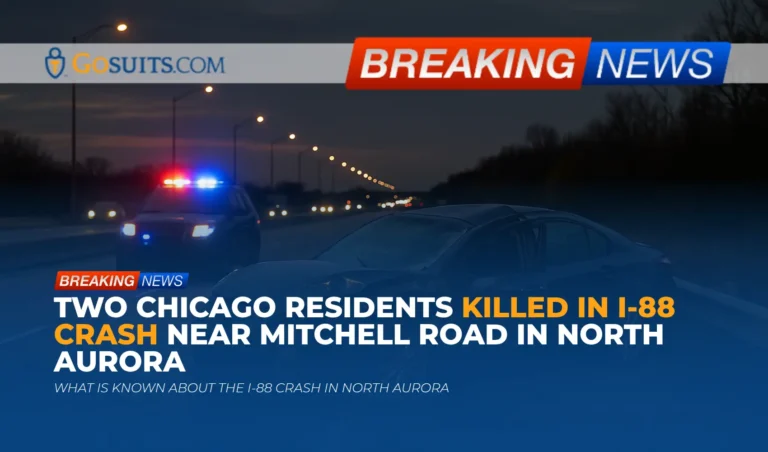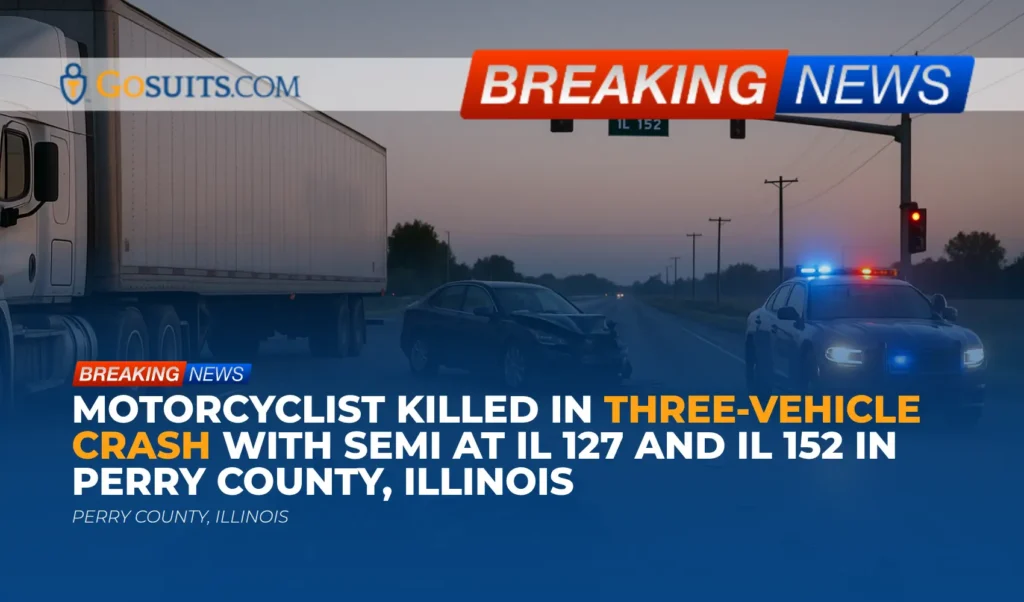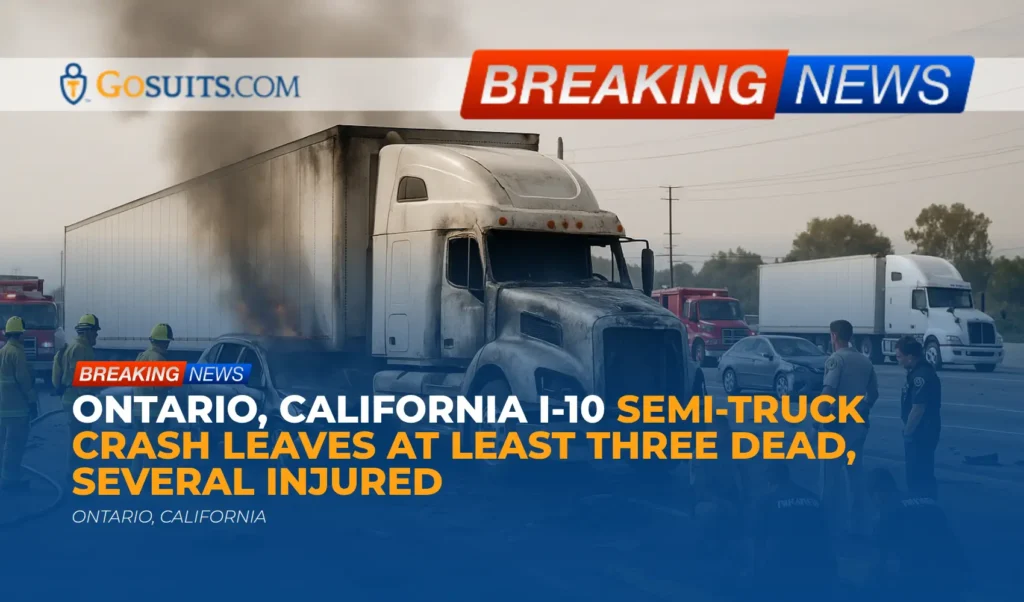- What is known about the I-88 crash in North Aurora
- How fatal interstate crashes are investigated in Illinois
- Where families can obtain official records and information
- Legal rights after a fatal single-vehicle crash in Illinois
- Insurance coverage issues that often arise
- Practical steps to protect a potential claim
- Safety context and data
- Commentary from Gosuits North Aurora, Illinois Personal Injury Attorney
- Why taking prompt action matters
What is known about the I-88 crash in North Aurora
Two Chicago residents, a 32-year-old man and a 33-year-old woman, were tragically pronounced deceased at the scene of a crash that occurred on Saturday evening in the westbound lanes of Interstate 88 near Mitchell Road in North Aurora. Authorities indicated the incident occurred at approximately 8:10 p.m.
According to preliminary public information, the Illinois State Police reported two vehicles were involved, while the county coroner’s office later described the incident as a single-vehicle crash. Autopsies reportedly indicated that the preliminary cause of death was consistent with multiple traumatic injuries sustained in a motor vehicle crash. The investigation remains active and is being pursued by the Illinois State Police in coordination with the county coroner.
When a loved one is lost on a high-speed interstate, the absence of immediate clarity can add to the pain and confusion. Early reports often evolve as investigators reconstruct the sequence of events, collect vehicle data, and analyze roadway evidence. Families deserve compassionate, accurate information, and this article aims to outline how investigations unfold, what records may be available, and how Illinois law generally treats fatal crashes.
Key facts summarized
- Location: Westbound I-88 near Mitchell Road, North Aurora, Illinois.
- Time: Approximately 8:10 p.m. on a Saturday.
- Victims: Two adults from Chicago, pronounced deceased at the scene.
- Vehicle involvement: Conflicting preliminary statements about whether one vehicle or two were involved; investigation ongoing.
- Investigating agencies: Illinois State Police and the county coroner’s office.
Out of respect for the families, details beyond what authorities have publicly shared are not included here. The information below explains typical investigative steps and the processes for obtaining official records in Illinois.
How fatal interstate crashes are investigated in Illinois
A fatal interstate crash sets in motion a detailed, methodical investigation. The Illinois State Police typically manage the crash scene on limited-access highways and coordinate with the local coroner’s office. Reconstruction specialists, evidence technicians, and medical examiners each have roles that fit together to form a final picture of what occurred.
Why early reports can conflict
Initial information almost always comes from fragmented sources: 911 calls, first-responder impressions, and the earliest officer observations. As officers secure the scene, lanes may be closed, vehicles moved for safety, or hazards addressed. Over the next hours and days, higher-confidence evidence emerges: measurements, vehicle data, witness interviews, and medical findings. It is common for the public record to shift from initial statements to a refined account once reconstruction is complete.
Typical steps in an Illinois fatal crash investigation
Scene documentation and reconstruction
Investigators document roadway evidence such as skid marks, yaw marks, gouges, fluid trails, debris fields, and vehicle resting positions. They may use total stations, drones, or laser scanners to create precise maps of the scene. Time-of-day, lighting, weather, and traffic control devices are recorded. The Illinois State Police Crash Reconstruction Unit typically synthesizes these data points into a sequence of events and contributing factors.
Vehicle data and electronic evidence
Modern vehicles often contain event data recorders, which store short-term data related to a crash, such as pre-impact speed, brake use, throttle, and seat belt status. The National Highway Traffic Safety Administration provides public information on EDR technology, what is typically recorded, and how it may be accessed and interpreted in legal proceedings. See NHTSA’s overview of event data recorders at nhtsa.gov.
Autopsy and toxicology
Under Illinois law, county coroners investigate deaths that may have occurred from trauma, including motor vehicle crashes. Autopsies and toxicology can help determine cause and manner of death and may contribute to the reconstruction of the event. Illinois statutes outline coroner duties and inquests, including deaths resulting from casualty or violence. See provisions in the Illinois County Code at ilga.gov.
Final reporting and timelines
Final crash reports may take weeks or months, depending on the complexity of the scene, pending lab results, and report reviews. Families typically receive preliminary information sooner and may later be able to request the final crash report, reconstruction supplements, photographs, and, where available, EDR data through appropriate channels. The coroner’s office generally releases autopsy findings consistent with state law and local policies.
Where families can obtain official records and information
After a fatal crash, there are multiple agencies and offices that may hold records. Although each family’s needs are different, the following sources are commonly relevant in Illinois. Contacting agencies with the date, time, location, and the names of the individuals involved can help staff locate records more quickly.
Illinois State Police: crash reports and investigation materials
On interstates, the Illinois State Police typically take the lead on crash reports. The North Aurora area is within the coverage of ISP District 2. The district’s public page provides contact information for questions about reports and procedures: isp.illinois.gov/Patrol/District02.
Depending on the case, available materials may include:
- Illinois Traffic Crash Report and any amendments
- Crash reconstruction supplements and diagrams, if produced
- Photographs and scene measurements, where releasable
- Witness statements, where releasable and not part of a restricted investigation
- EDR downloads, if applicable and available
If records are not immediately available, staff can generally provide guidance on timelines and the appropriate process to request documents later.
Kane County coroner: autopsy, reports, and inquest files
County coroners in Illinois have statutory authority to investigate deaths involving potential trauma, including traffic crashes. Reports can include death investigation narratives, autopsy and toxicology results, and any inquest findings. The legal framework for coroner duties is set out in the Illinois County Code, see relevant provisions at ilga.gov. Families and legal representatives typically may request copies consistent with state law and privacy rules.
Medical privacy rules allow personal representatives of a deceased individual to access protected health information as needed to settle affairs. The U.S. Department of Health and Human Services explains HIPAA’s provisions regarding disclosures after death, including the authority of a decedent’s personal representative. See HHS guidance on the HIPAA Privacy Rule and deceased individuals at hhs.gov.
Death certificates
Certified death certificates in Illinois are issued through the Illinois Department of Public Health’s Division of Vital Records. Eligibility, required documentation, and ordering details are provided by IDPH at dph.illinois.gov. Funeral homes often assist families with this step, but it can also be handled directly.
Freedom of Information Act (FOIA) requests
Many public records in Illinois can be requested under the Illinois Freedom of Information Act, with certain exemptions for active investigations, personal privacy, and other protected categories. The statute is at 5 ILCS 140. Agencies generally provide FOIA submission instructions on their websites, and response timelines are set by law.
Legal rights after a fatal single-vehicle crash in Illinois
Every loss on the roadway is personal, and the law offers a framework for civil accountability when negligence or wrongful conduct contributes to a death. While each situation is fact-specific, families commonly consider the following Illinois laws and potential avenues for civil claims. This section is for general information only.
Wrongful Death Act
Illinois allows an action for the benefit of surviving next of kin when a death is caused by wrongful act, neglect, or default. The statute sets out who may bring the claim, how damages are assessed for the survivors’ loss, and the general filing period. See the Wrongful Death Act at 740 ILCS 180. The statute of limitations is often two years from the date of death, though exceptions can apply based on circumstances specified in the Act.
Survival claims
Illinois law also permits claims that the deceased person could have brought had they lived, such as for conscious pain and suffering and other damages sustained between injury and death. Survival actions are typically brought by the estate’s representative. See relevant provisions including the Survival Act and related limitations rules at 755 ILCS 5 and limitations provisions in 735 ILCS 5. Timelines can be nuanced; prompt legal guidance is recommended to avoid missing deadlines.
Potential liability avenues in single-vehicle crashes
Even when early reports suggest only one vehicle was involved, liability may still exist depending on the evidence. Common avenues include:

Vehicle defects and product liability
If a vehicle system fails unexpectedly, a defect claim against a manufacturer or supplier may be investigated. EDR data, maintenance records, recalls, and physical inspection of components like tires, braking systems, and steering can be critical. NHTSA maintains recall databases and technical information that can help identify known defects, available at nhtsa.gov/recalls.
Roadway design, signage, and maintenance
Claims involving roadway conditions can arise where the design, maintenance, or signage allegedly presented an unreasonable risk. In Illinois, public entities may be protected in part by the Local Governmental and Governmental Employees Tort Immunity Act, which sets conditions for liability and notice. See 745 ILCS 10. Claims involving the State of Illinois can implicate separate procedures and forums. Due to strict timelines and immunities, these cases require careful, early assessment.
Third-party negligence off-scene
Not all negligence occurs at the crash site. Examples can include improperly secured cargo from another vehicle that fell earlier, unreported prior collisions that left debris or fluids, or negligent repair work that failed shortly after service. Investigators often look for physical clues and video evidence to trace such factors.
Insurance coverage issues that often arise
Insurance can be complex in fatal single-vehicle cases. Multiple policies may apply, and coverage questions often hinge on details that emerge only after a thorough investigation. Before speaking with any insurance company, it is wise to consult a qualified attorney; what is said to an insurer can be recorded and may be used later in ways that affect the claim.
Liability coverage
If another party’s negligence contributed to the crash, their liability coverage is a primary avenue for recovery. In single-vehicle scenarios, liability coverage might still come into play through product liability, roadway-related theories, or third-party negligence identified by investigators.
Uninsured and underinsured motorist (UM/UIM)
UM/UIM coverage may apply if an unidentified or uninsured negligent driver contributed to the crash (for example, forcing evasive action without contact). These claims can be difficult to prove without prompt evidence collection. Policy language and state law govern proof requirements.
Medical payments (MedPay) and other first-party benefits
Some auto policies include MedPay, which can help with certain expenses regardless of fault. Policies vary considerably, and benefits are usually limited. Review of policy declarations and endorsements is important.
Practical steps to protect a potential claim
Every case is unique, but the following practical measures often help protect the truth and the family’s rights after a serious crash.
Evidence preservation checklist
- Preserve the vehicles: Avoid early disposal of the vehicle. Ask the tow yard or insurer to hold the vehicle pending inspection. Important data and mechanical evidence can be lost if a vehicle is moved or destroyed prematurely.
- Secure photographs and video: Save any phone photos, dashcam footage, or nearby security camera video. Footage can be overwritten quickly, sometimes within days.
- Request that agencies retain data: Ask investigating agencies about retention of scene photos, measurements, 911 audio, and EDR downloads, if applicable. Formal requests may be needed later.
- Identify witnesses: Write down names, contact details, and what each person observed. Time can blur memories.
- Collect maintenance and recall records: Gather vehicle service history, tire purchase dates, and check for open recalls at nhtsa.gov/recalls.
Communications with insurance companies
- Consider speaking with a lawyer first: Consult with an attorney before giving recorded statements to any insurer, including your own. Statements may be used later to challenge coverage or liability.
- Limit speculation: Share only confirmed facts. Avoid guessing about speed, distraction, or other potential causes before the investigation is complete.
- Keep a written log: Note dates, names, and details of all insurance communications. Save letters and emails.
Social media and public statements
- Use caution online: Posts can be screenshotted and misinterpreted. Even well-meaning updates may be taken out of context.
- Centralize updates: Consider designating one person to communicate with insurers and agencies to reduce confusion.
Safety context and data
While every crash is personal, broader safety data can help communities understand the risks that interstates present and why reconstruction work matters.
Single-vehicle fatality share
According to the National Highway Traffic Safety Administration’s Traffic Safety Facts, single-vehicle crashes account for over half of motor vehicle traffic fatalities nationwide. In 2022, single-vehicle crashes represented approximately 54 percent of traffic deaths in the United States. See NHTSA’s overview at crashstats.nhtsa.dot.gov and the Traffic Safety Facts “Overview” series on nhtsa.gov.
Speed and impairment remain common factors
NHTSA reports that speeding continues to be a significant contributor in fatal crashes, with speed-related deaths constituting a substantial share annually. National summaries indicate about 29 percent of traffic fatalities involved speeding in 2022. See NHTSA’s Speeding Traffic Safety Facts at nhtsa.gov. Alcohol impairment also remains a persistent factor, as reflected in NHTSA’s impaired driving data.
These national figures are not statements about any specific crash. They illustrate why investigators examine speed, impairment, road conditions, mechanical condition, and driver behavior in every fatal case.

Agencies and offices families can contact for help
The following agencies are typically involved in fatal interstate investigations in this area. Staff can explain report availability and timelines. When calling, have the date, time, location, and names of those involved.
- Illinois State Police, District 2: Public information and contact details are available at isp.illinois.gov/Patrol/District02. Ask about the crash report, any reconstruction supplements, and the process to request records as they become available.
- County coroner’s office: Request information about the death investigation, autopsy, and any inquest records. Coroner duties in Illinois are set by statute, see the Illinois County Code at ilga.gov.
- Illinois Department of Public Health, Vital Records: For certified death certificates, see IDPH guidance at dph.illinois.gov.
- FOIA requests: If you need public records, the Illinois Freedom of Information Act is at 5 ILCS 140. Agencies typically describe how to submit FOIA requests on their websites.
Commentary from Gosuits North Aurora, Illinois Personal Injury Attorney
Our hearts go out to the families and friends grieving this loss. This article is shared for educational purposes and general information during a difficult time. We recognize that behind every headline are loved ones, unanswered questions, and the need for clear, respectful guidance.
From a civil injury perspective, it is not unusual to see early differences in official descriptions, such as whether one or two vehicles were involved. Those differences can resolve as forensic work concludes. On an interstate at night, even small variables in lighting, visibility, road friction, or vehicle condition can matter. That is why preserving vehicles, scene data, and electronic records is so important.
Insurance companies and large corporations often move quickly after a loss. Adjusters may reach out early for recorded statements or authorizations that seem routine. Without context, families can unintentionally limit coverage, accept premature fault, or sign broad releases. The imbalance of information at the start is significant: insurers may already have specialists reviewing photos, black-box data, and policy language while the family is still awaiting official reports. A brief, no-cost consultation with a seasoned and skilled attorney can help identify priorities, avoid missteps, and ensure that critical evidence is preserved while timelines are still open.
Why taking prompt action matters
The period immediately following a fatal crash is painful and overwhelming. Yet certain steps, if taken promptly, can significantly affect how completely the truth is documented and whether civil claims remain viable. The following considerations explain why timely action matters and what concrete steps can help:
- Evidence can be lost quickly: Vehicles may be moved or scrapped, dashcam systems overwrite, and nearby businesses routinely delete footage on short cycles. Acting early to preserve vehicles and request that potential video be saved can prevent permanent loss of key facts.
- Deadlines apply: Illinois law imposes time limits on civil actions, often measured in years but sometimes shorter for specific claims or parties. Waiting until final reports are issued can compress the time left to assess claims, notify insurers, and file in the proper forum.
- Insurance positioning starts early: Insurers may set reserves, analyze coverage defenses, or seek recorded statements quickly. Early guidance helps align communications with the facts and the family’s rights.
- Complex theories need runway: Product liability, roadway design, and third-party negligence theories often require expert review and formal requests to agencies or manufacturers. Those steps take time and coordination.
- Compassionate support and clarity: Having a plan for requesting records, preserving evidence, and managing insurance communications can reduce confusion and allow space for grieving while protecting important rights.
Practical first steps include identifying and preserving the involved vehicle, noting towing and storage locations, keeping a written log of agency and insurer contacts, and organizing documents such as policy declarations and any photographs. Before contacting any insurance company for a statement, arrange a free consultation with a qualified attorney to understand rights and responsibilities; statements given to insurers can be used later and may affect coverage or liability assessments.
Additional guidance and references
The following official sources provide useful background on investigation and legal frameworks mentioned above:
- Illinois State Police District 2: Contact and district information for the North Aurora area: isp.illinois.gov/Patrol/District02.
- Illinois Wrongful Death Act: 740 ILCS 180.
- Tort Immunity Act for local public entities: 745 ILCS 10.
- Illinois FOIA statute: 5 ILCS 140.
- NHTSA event data recorders overview: nhtsa.gov.
- NHTSA CrashStats and Traffic Safety Facts: crashstats.nhtsa.dot.gov.
- NHTSA Speeding overview: nhtsa.gov.
- IDPH Death Records: dph.illinois.gov.
- HHS HIPAA access to records for personal representatives and deceased individuals: hhs.gov.
We remain mindful that investigations take time and that news updates can change as facts develop. Families can check with the Illinois State Police or the county coroner’s office for status updates on report availability and next steps.






